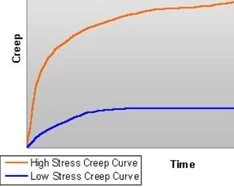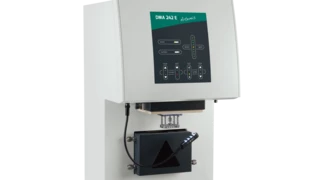Glossary
Creep (DMA)
Creep describes a time and temperature dependent plastic deformation under a constant force. When a constant force is applied to a rubber compound, the initial deformation obtained due to the application of the force is not fixed. The deformation will increase with time. Creep takes place!

Creep-Behavior
Creep behavior is the term for describing the creep processes taking place in different materials.
Depicted in the figure are the characteristics of a high-StressStress is defined as a level of force applied on a sample with a well-defined cross section. (Stress = force/area). Samples having a circular or rectangular cross section can be compressed or stretched. Elastic materials like rubber can be stretched up to 5 to 10 times their original length.stress and low-StressStress is defined as a level of force applied on a sample with a well-defined cross section. (Stress = force/area). Samples having a circular or rectangular cross section can be compressed or stretched. Elastic materials like rubber can be stretched up to 5 to 10 times their original length.stress creep curve. The figure shows creep over time.
RelaxationWhen a constant strain is applied to a rubber compound, the force necessary to maintain that strain is not constant but decreases with time; this behavior is known as stress relaxation. The process responsible for stress relaxation can be physical or chemical, and under normal conditions, both will occur at the same time. Relaxation, creep and Creep RecoveryCreep recovery is the ratio of the recoverable creep compliance to initial creep compliance given in percent. Often in MSCR (multiple stress creep recovery) testing, creep recovery is considered a performance indicator with more recovery indicating a binder less prone to rutting.creep recovery processes can be measured with the NETZSCH DMA Eplexor®® and DMA 242 Artemis®.


